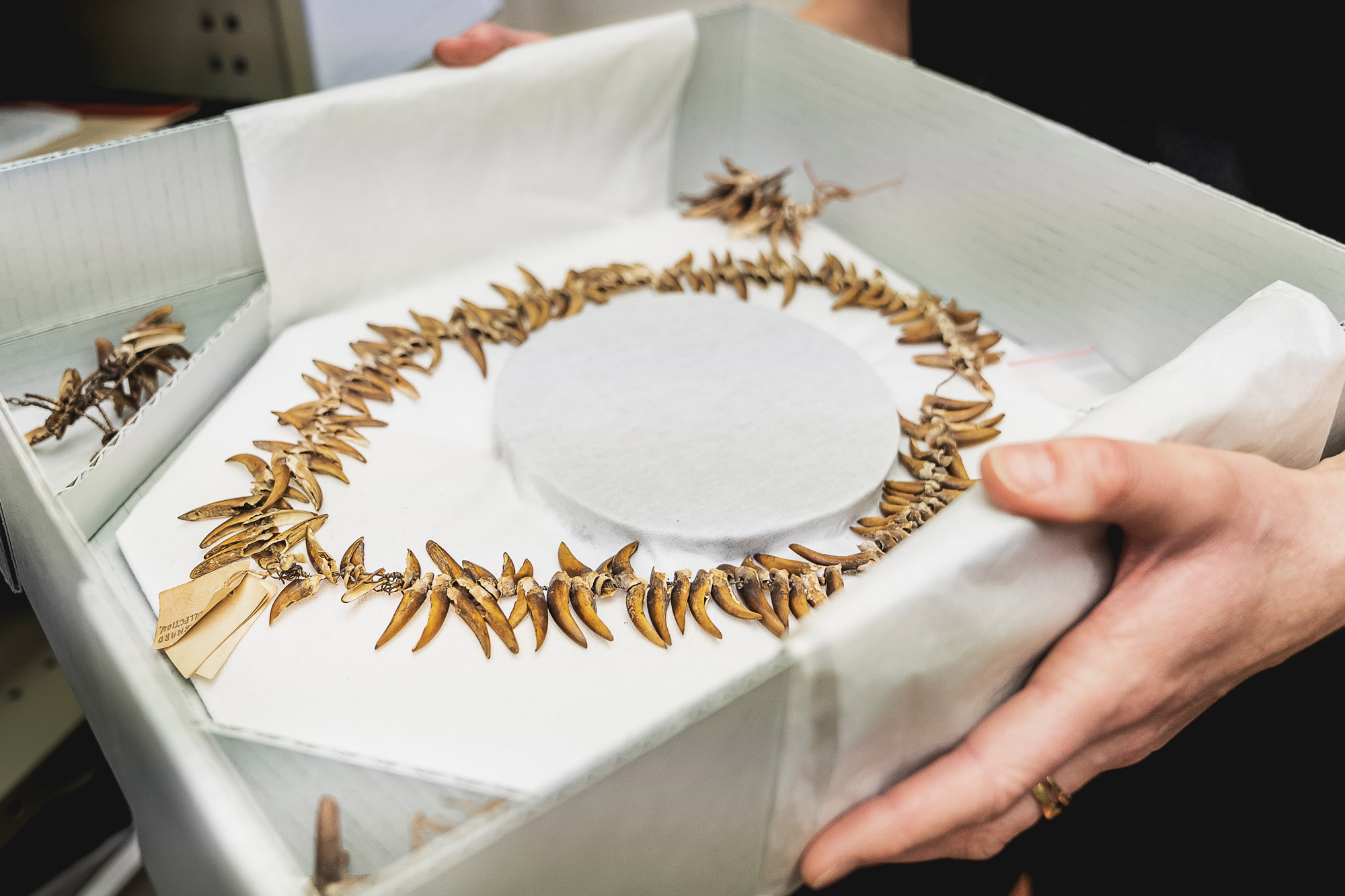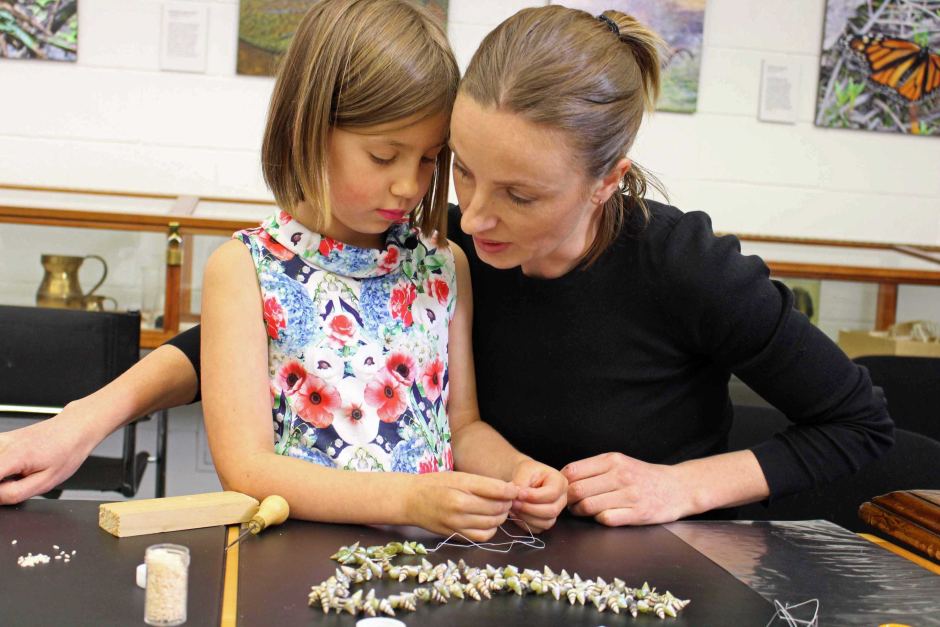Acknowledgement of Country
Mina tunapri milaythina nara ningina waranta mapali mapali. Mina tunapri rruni lutruwita milaythina Pakana taymi ningina raytji. Mina tunapri Pakana Ngini; nara pumili makuminya waranta-mapali taypani lunta; Pakana-mana-mapali wanapakalali tunapri ngini Pakana Ngini. Waranta putiya makara muylatina takila-ti paywuta manta
This is a statement acknowledging Country for all she provides, and reminding people that the island of lutruwita (Tasmania) is unceded Aboriginal land. I also remember the Ancestors, Pakana Ngini, who paved the way for us, and for the future generations; and pledge that we will never stop caring for and protecting our cultural heritage.
– Zoe Rimmer
Alumna Zoe Rimmer is one such leader, a Pakana (Tasmanian Aboriginal) community member and Indigenous Fellow at the University. Zoe’s work in cultural heritage illustrates the benefits that can come from connecting with this island’s past and revitalising and reconnecting with cultural items for the future.
Most recently, Zoe was Senior Curator of First Peoples Art and Culture at the Tasmanian Museum and Art Gallery (TMAG). She was a Churchill Fellow in 2013, which saw her travel to the United States, Canada, the UK and France. Her research, including her current PhD, has a focus on repatriating objects from cultural collections overseas and acknowledges the large impact the Tasmanian Aboriginal community has had in this space.
“The Tasmanian Aboriginal community has spearheaded this on a world-scale,” Zoe said.
The recent rediscovery of a kelp basket in a French museum, the type of object Zoe and her colleague Dr Gaye Sculthorpe have been searching for for many years, epitomises the value of this research.
True origins
Despite numerous attempts to locate cultural material taken by crew from the d’Entrecasteaux expedition to Tasmania in 1792-93, no items were forthcoming – until it was realised that an object catalogued as an ‘African bark basket’ was in fact a rikawa kelp basket from lutruwita (Tasmania).
Zoe explains that when the French expedition was on the return to France, d’Entrecasteaux died and his ship was handed to the Dutch. It was then intercepted by the British who confiscated all materials and sent them to England; France and England were at war at the time. The materials were eventually sent back to France. The kelp basket was one of these items, and was variously mislabelled as being from New Zealand and Africa before its true origins were rediscovered.
“It has been missing for 120 years and now is the oldest Tasmanian Aboriginal basket surviving.”
“We’re very excited that the museum in Paris is open to the rikawa being returned on a two-year loan,” Zoe said.
It is hoped the basket will feature in TMAG’s taypani milaythina-tu: Return to Country exhibition, which Zoe is assisting with. The exhibition features contemporary cultural and artistic responses to ancestral material objects held in museums and collections around the world.
Also being returned are two items from the United Kingdom. Zoe describes opening an email from the Derbyshire Council Archives and seeing the images of a small doll and a pincushion labelled as belonging to ‘Mathinna’ (Mithina).
The pincushion was thought to have been made by Mithina, the Aboriginal child who had been taken by Lady Jane and Sir John Franklin, then Lieutenant Governor of Tasmania, to live with them at Government House. Mithina was abandoned to the Queen’s Orphanage in New Town when the Franklins returned to England in 1843 taking her doll and pincushion with them.
“It was a bit overwhelming,” Zoe said.
“They are such sweet and innocent objects, but so tragic… given what that little doll and pincushion represent.”
Zoe studied Fine Arts at the University of Tasmania before starting a traineeship at TMAG with then curator Tony Brown, returning to the University with the museum’s support to complete her studies, by then a combined degree, including Aboriginal Studies and History.
Together with Tony, and considerable Aboriginal community input, Zoe helped develop the first Aboriginal-curated permanent exhibition at the museum.

One of Zoe’s first tasks as a trainee was cataloguing and photographing Aboriginal shell necklaces, items she had a strong connection with. Zoe describes collecting shells on Tasmania’s north-west coast as a child, although her family’s ancestral connection is to the Bass Strait islands.
“Even though I’d grown up as part of the Pakana community and shell collecting was part of what we did, I hadn’t actually learned the full process of making shell necklaces,” Zoe said.
“And so, having access to that collection of historic necklaces, and more contemporary ones, I was just absolutely fascinated by the variety of shells and the patterns and the stories that went along with them.”
The necklaces featured in TMAG’s luna tunapri: Women’s Knowledge project, which Zoe coordinated from 2010.
“The shell necklaces inspired a lot of that work, around using the collection, engaging with Elders and bringing community together to learn and revitalise that practice, and then developing it into what became a national touring exhibition (kanalaritja: An Unbroken String), a book and a documentary film.”
Reviving cultural practice
Zoe describes the joy of learning shell necklace making as a cultural practice with her daughter and mother alongside her.
“I feel incredibly lucky and proud to have worked with my community and to be able to share our stories across the country,” she said.
She says such objects provide opportunities for discussion as well as “oral histories that can help our community to revive cultural practice, or just be able to tell our own stories”.
“The ultimate goal is for the Pakana community to have our own space to care for, re-contextualise and share these objects.”

Zoe says she has noticed a shift in recent years towards understanding the importance of respecting First Nations’ culture.
She recognises the work of former Pro Vice-Chancellor, Aboriginal Research and Leadership, Professor Maggie Walter (BSW Hons 1998, PhD 2003) and Professor Greg Lehman (BSc 1984, GradDipEnvSt Hons 1998, PhD 2017) in promoting First Nation perspectives and content across the University.
“We have the opportunity to engage every single student that comes through this institution."
“I think that’s really important both in terms of understanding the Tasmanian Aboriginal community and our deep history and our culture, but also valuing it.
“When the broader community are interested in, and value Aboriginal perspectives and connect in some way with the deep history of lutruwita (Tasmania) that’s when we see some really amazing things happen; significantly, this includes understanding and promoting the importance of the protection of our cultural heritage.”
Written by Katherine Johnson for Alumni Magazine Issue 53, 2022.
Connect with our alumni community to discover more.
Top of page: Zoe Rimmer in the Tasmanian Museum and Art Gallery archives. Image: Joe Chelkowski, Tasmanian Tuxedo.


